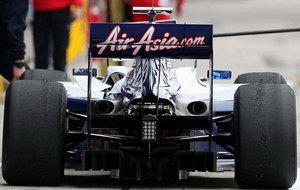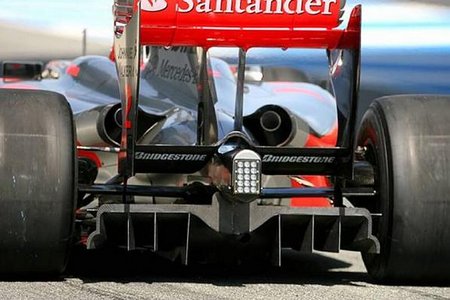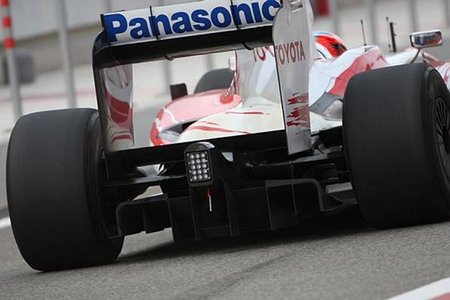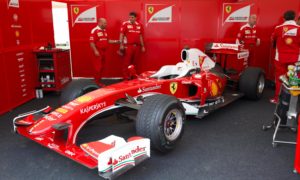 With an announcement from the FIA expected within the next twenty four hours on the legality of the controversial ‘double-decker’ diffuser, Forumula1.com takes a closer look at the device which could make-or-break Jenson Button’s championship charge.
With an announcement from the FIA expected within the next twenty four hours on the legality of the controversial ‘double-decker’ diffuser, Forumula1.com takes a closer look at the device which could make-or-break Jenson Button’s championship charge.
What is a diffuser?
The diffuser on a Formula One car is a crucial aerodynamic component that sits on the floor of the car between the rear wheels and under the rear wing. It works by sucking in the underbody airflow and reducing the air pressure underneath the car to increase downforce and grip.
How have the diffusers changed for 2009?
The 2009 regulations have been designed to spur overtaking by enabling the cars to run closer together through reducing downforce levels. These aerodynamic changes have included a smaller diffuser in a more rearward position.
The new regulations now limit the main part of the diffuser to a width of 1000mm, a length of 350mm and a height of 175mm. All of the channels must be the same height and length, with no difference in height between the main central section and the side channels.
Why have teams protested against the diffusers on the Brawn GP, Williams and Toyota cars?
McLaren, Ferrari, Renault and BMW Sauber all made very literal interpretations of the rules and designed a single 1000mm wide diffuser channel that is the same height all the way across.

McLaren opted for a single diffuser channel.
Brawn GP, Williams, and Toyota, on the other hand, exploited a loophole in the rules that says that the diffuser is merely one section of the wider bodywork structure.
While the protesting teams have just a single diffuser channel, Brawn, Williams and Toyota have cleverly split their diffuser into three using the rear crash structure as a central channel. This lengthens and heightens the diffuser’s central section, which creates a bigger diffuser exist area. This in turn enables the air to flow through faster which generates more downforce.

Toyota have developed a double-decker diffuser with a wider central channel
“Toyota’s diffuser makes a very interesting interpretation of the revised 2009 rules (and one that has already prompted speculation regarding its legality),” explains the official Formula One website. “By exploiting regulations that allow extra bodywork within a 150mm zone in the centre of the car, the team appear to have cleverly shaped the TF109’s rear crash structure so that it effectively lengthens and heightens the diffuser’s central section, which also features a very low splitter at its base.
“Like engine supplier Toyota, Williams’ interpretation of the revised diffuser regulations is highly innovative. Much of the diffuser’s central section is actually lower than the outer sections. However, clever shaping of the rear crash structure immediately below the rear light effectively creates a second central section. In combination, the result is a central section that exceeds the 175mm height allowance that applies to the diffuser alone.”
Crucially, all three teams have made use of the ambiguity around the number of surface areas that are allowed in the rear bodywork area. By virtue of splitting their diffuser and having a second layer the teams have been able to create a bigger ‘window’ or hole by cutting the middle section short and stopping the connection to the flat floor. Instead the floor extends to the upper diffuser which creates the larger diffuser area.
With Brawn, Williams and Toyota all enjoying a clear advantage at the opening two races of the season it is not surprising that their rivals lodged formal protests against the design.
What happens if the FIA declare the diffusers legal?
This is the more likely scenario given that FIA president Max Mosley has already given the device the thumbs up, and that all the teams are developing their own version of the diffuser design.
If the diffusers are declared legal the rest of the field will be forced develop their own designs which could see the current diffuser gang dominate the season as a result of their head start. Renault have a design ready to run in this weekend’s Chinese Grand Prix, while Ferrari recently restructured their trackside operations to integrate new components such as this onto their car quicker
Besides the logistical problems involved in making changes of this scale, there are also high costs involved which many teams have complained about.
What happens if the FIA say that the diffusers are illegal?
The FIA will do one of two things. Either it will allow the results of the first two races to stand but force Brawn, Williams and Toyota to amend their cars for Sunday’s Chinese Grand Prix and beyond. Or the governing body could strip away the teams’ results which will no doubt cause uproar amongst sports fans.
That would have detrimental consequences for Jenson Button and Brawn GP who won both the opening races.








